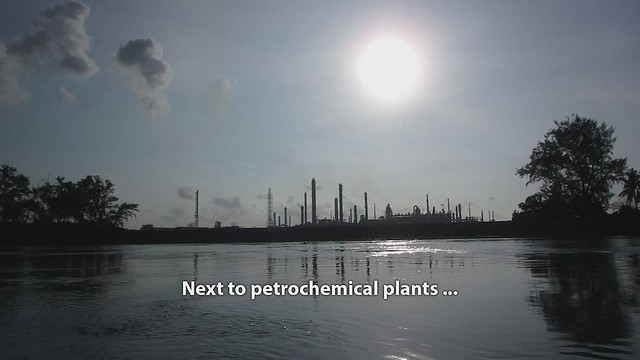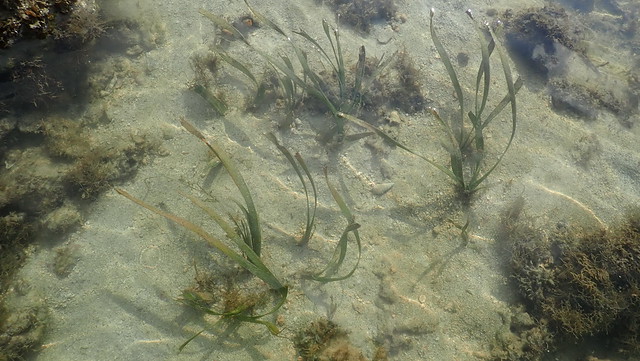Although we didn't find any Giant clams, and there seems to be a new hole on the reef from a recent boat strike. The rest of the team saw cushion stars, special slugs and more!
Here's a brief video of the living reefs of Terumbu Hantu today. Although it lies next to the massive petrochemical plants of Pulau Bukom, there are still lots of corals on this tiny reef flat. Sadly, we didn't come across any Giant clams.
There were large coral colonies including of Lettuce corals, Pebble corals, Moon corals, Galaxy corals. There were also many Anemone corals. As well as commonly seen Pore corals and Merulinid corals. Most seemed alright, although some Pore corals had pale tops.
A glimpse of some of the variety of corals found close to one another.
I saw many mushroom corals of various kinds and all of them were alright. There were many Tongue mushroom corals and Bracket mushroom coral. As in our last survey in Jul 2018, I continued to see some Circular mushroom corals and Feather mushroom corals. I didn't see during our survey in Apr 2017. Most were alright, except some of the Circular mushroom corals were white.
I saw nice large colonies of plate corals including Ridged plate corals, Ringed plate coral, and some large colonies of Disk coral. Most were alright although some of the Flowery disk corals were very pale.
There were happy Lettuce corals, Castle coral, Carnation corals, Pebble corals, Brain corals, Moon corals. They were mostly alright, although some Pebble coral colonies were yellow or pale. I didn't come across any Acropora corals. I saw one plate forming Hedgehog coral that was partially bleaching.
I saw some Sandpaper corals and Cauliflower corals that were okay, but some that had pale or dead patches. I saw happy Trumpet corals and Anchor corals that were not bleaching. These are usually the first to succumb during bleaching events.
Today, I saw one Merten's carpet anemone. There were also some Giant carpet anemones, and for the first time, I saw a small Magnificent anemone. Kelvin also spotted a Pizza anemone. All of them were alright.
There were also many large colonies of Leathery soft corals of various kinds. None of them were bleaching.
There were a few Flowery soft corals, they were also alright.
I saw a few scattered clumps of Tape seagrass and they all had longish leaf blades (about 30cm). During our last survey in Jun 2018, those I saw were mostly cropped short - hopefully this is a sign of a recovery?
As usual, we dropped by Terumbu Pempang Kecil nearby after rising tides submerged Terumbu Hantu. There is still sprinkles of Spoon seagrass on Terumbu Pempang Kecil, on the side nearer Jurong Island.
One reason we visit this submerged reef is that it has been damaged by large dive boats in the past. This is a photo of the MV Nautica a large live-aboard dive boat which was seen high and dry on the living reefs of Terumbu Hantu on 9 Nov 2014. We checked for damage to Terumbu Hantu in Jan 2015 and again in Aug 2015.
 |
| Photo by Toh Chay Hoon on facebook. |
The impact of the boat had churned up the rubble to such a height that it was the largest area sticking out of the water. So we left our life vests there after landing at a higher tide, not realising there was a hole next to it.
Fate of Terumbu Hantu?
Terumbu Hantu is one of the existing natural shores that may be impacted by the landuse plan by the Ministry of National Development released in Jan 2013 in response to the Populations White Paper with a 6.9 million population target. The dotted margined blue areas are "Possible Future Reclamation".


The Singapore Blue Plan 2018
Pulau Semakau and nearby islands and submerged reefs have been recommended by the Singapore Blue Plan 2018 for Immediate Conservation Priority. The Blue Plan recommends the intertidal and subtidal marine areas of Pulau Semakau and adjacent Pulau Hantu, and Pulau Jong to be designated Marine Reserve.
The Blue Plan highlights that Pulau Semakau and its associated patch reefs comprise many ecosystems: coral reefs, mangrove areas, intertidal sandflats, seagrass meadows, and coral reefs. The subtidal area of Pulau Jong is larger than the terrestrial area. Pulau Hantu is a popular dive site has seen increasing interest in the past decade due to biodiversity awareness. If protection is accorded to these three islands, zonation plans for use can be implemented to manage tourism and human impacts.
DOWNLOAD the Plan, SUPPORT the Plan! More on the Singapore Blue Plan 2018 site.
Posts by others on this trip
Richard Kuah
Chay Hoon
Juria Toramae
Liz Lim
Yeo Jing Ying
Kelvin Yong
Others on this trip: Jeanette, James.















